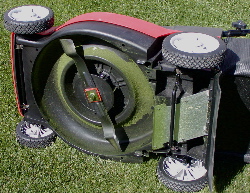Riding Lawn Mower Comparisons
As you compare riding lawn mowers, make sure you take into consideration several aspects such as the lawn area, type of mowing, turning radius, maintenance requirements and the cost and size of the mower. You can gather information regarding these aspects in the top brands for riding lawn mowers like Honda, Snapper, Toro, John Deere, Craftsman and Black and Decker. You can also go through the best riding lawn mower reviews of the manufacturers.
Riding Lawn Mower Deck Size: If you have comparatively a large lawn, it is obvious that a high performance riding lawn mower will be the ultimate choice. A bigger deck size is effective for covering large lawn area at a time. Nevertheless, if there are shrubs, trees or other obstacles in the lawn, you can select a unit with smaller deck size. Along with the size of the riding lawn mower, the performance of the model is equally important.
Riding Lawn Mower Engine: In general, there are three models of riding lawn mowers based on the engine types. The first one is operated by using gasoline (air cooled), gasoline (liquid cooled) and diesel (liquid cooled). In an air cooled model, the engine is operated by installing a fan adjacent to the engine, while fluids are used in case of a liquid cooled type.
Riding Lawn Mower Turning Radius: The turning radius is another aspect to compare riding lawn mowers. Depending upon the turning radius, there are two basic models, namely, all-wheel and zero-turn. The latter unit is becoming very popular as you can turn the mower in any direction at any time. A zero-turn model is comparatively easy, safe and less time consuming to mow a lawn than the conventional all-wheel unit.
Riding Lawn Mower Safety: Whatever be the type of riding lawn mower that you choose, the most important factor is the safety of the unit. Every year, casualties are reported due to riding lawn mowers. Some common causes of accidents include lost stability, blade contract and tipping over of the machine.
As you compare riding lawn mowers, make sure you take into consideration several aspects such as the lawn area, type of mowing, turning radius, maintenance requirements and the cost and size of the mower. You can gather information regarding these aspects in the top brands for riding lawn mowers like Honda, Snapper, Toro, John Deere, Craftsman and Black and Decker. You can also go through the best riding lawn mower reviews of the manufacturers.
Riding Lawn Mower Deck Size: If you have comparatively a large lawn, it is obvious that a high performance riding lawn mower will be the ultimate choice. A bigger deck size is effective for covering large lawn area at a time. Nevertheless, if there are shrubs, trees or other obstacles in the lawn, you can select a unit with smaller deck size. Along with the size of the riding lawn mower, the performance of the model is equally important.
Riding Lawn Mower Engine: In general, there are three models of riding lawn mowers based on the engine types. The first one is operated by using gasoline (air cooled), gasoline (liquid cooled) and diesel (liquid cooled). In an air cooled model, the engine is operated by installing a fan adjacent to the engine, while fluids are used in case of a liquid cooled type.
Riding Lawn Mower Turning Radius: The turning radius is another aspect to compare riding lawn mowers. Depending upon the turning radius, there are two basic models, namely, all-wheel and zero-turn. The latter unit is becoming very popular as you can turn the mower in any direction at any time. A zero-turn model is comparatively easy, safe and less time consuming to mow a lawn than the conventional all-wheel unit.
Riding Lawn Mower Safety: Whatever be the type of riding lawn mower that you choose, the most important factor is the safety of the unit. Every year, casualties are reported due to riding lawn mowers. Some common causes of accidents include lost stability, blade contract and tipping over of the machine.

No comments:
Post a Comment